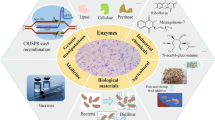Abstract
We imaged pores on the surface of the cell wall of three different industrial strains of Saccharomyces cerevisiae using atomic force microscopy. The pores could be enlarged using 10 mM diamide, an SH residue oxidant that attacks surface proteins. We found that two strains showed signs of oxidative damage via changes in density and diameter of the surface pores. We found that the German strain was resistant to diamide induced oxidative damage, even when the concentration of the oxidant was increased to 50 mM. The normal pore size found on the cell walls of American strains had diameters of about 200nm. Under conditions of oxidative stress the diameters changed to 400nm. This method may prove to be a useful rapid screening process (45-60 min) to determine which strains are oxidative resistant, as well as being able to screen for groups of yeast that are sensitive to oxidative stress. This rapid screening tool may have direct applications in molecular biology (transference of the genes to inside of living cells) and biotechnology (biotransformations reactions to produce chiral synthons in organic chemistry.
Similar content being viewed by others
References
Binnig G, Quate CF, Gerber Ch: Atomic force microscope. Phys Rev Lett 56: 930–933, 1986
Yang J, Tamm L K, Somlyo AP, Shao Z: Promises and problems of biological atomic force microscopy. J Microsc 171: 183–198, 1993
Morris VJ: Biological applications of scanning probe microscopies. Prog Biophys Molec Biol 131–185, 1994
Roberts CJ, Williams PM, Davies MC, Jackson DE, Tendler SJB: Atomic force microscopy and scanning tunnelling microscopy: Refining techniques for studying biomolecules. Tibtech 12: 127–132, 1994
Pereira RS, Parizotto NA, Baranauskas V: Observation of baker's yeast strains used in biotransformation by atomic force microscopy. Appl Biochem Biotechnol 59: 135–143, 1996
Brady D, Glaum D, Duncan JR: Copper tolerance in Saccharomyces cerevisiae. Lett Appl Microbiol 18: 245–250, 1994
Mogren H, Hedenskog G, Hofsten A: The influence of heat processing and mechanical disintegration on yeast for single-cell protein. Physiol Plant 29: 82–91, 1973
Bowen RW, Sabuni HAM, Ventham TJ: Studies of the cell-wall properties of Saccharomyces cerevisiae during fermentation. Biotechnol Bioeng 40: 1309–1318, 1992
Costaglioli P, Meilhoc E, Masson JM: High-efficiency electrotransformation of the yeast Schwanniomyces occidentalis. Curr Genetics 27: 26–30, 1994
Wolf H, Rols MP, Boldt E, Neumann E, Teissie J: Control by pulse parameters of electric field-mediated gene-transfer in mammalian-cells. Biophys J 66: 524–531, 1994
Gustafson VD, Baenziger PS, Mitra A, Kaeppler HF, Papa CM, Kaeppler SM: Electroporation of wheat anther culture-derived embryoids. Cer Res Comm 23: 207–213, 1995
Muraji M, Tatebe W, Berg H: The influence of extracellular alkali and alkaline-earth ions on electropermeation of Saccharomyces cerevisiae. Bioelectrochem Bioenerg 46: 293–295, 1998
Teissie J: Transfer of foreign receptors to living cell surfaces: The bioelectrochemical approach. Bioelectrochem Bioenerg 46: 115–120, 1998
Ganeva V, Galutzov B, Teissie J: Electric-field mediated loading of macromolecules in intact yeast-cells is critically controlled at the wall level. Biochim Biophys Acta – Biomembranes 1240: 229–239, 1995
Benov LC, Antonov PA, Ribarov SR: Oxidative damage of the membrane-lipids after electroporation. Gen Physiol Biophys 13: 85–97, 1994
Maccarrone M, Rosato N, Agro AF: Electroporation enhances cellmembrane peroxidation and luminescence. Biochem Biophys Res Comm 206: 238–245, 1995
Mihai R, Cogalniceann G, Brezeanu A: Control of Nicotiana-Tabacum callus growth by alternating and pulsed electric-field. Electro Magnetobiol 13: 195–201, 1994
Sorrilha AEPM, Marques M, Joekes I, Morán PJS, Rodrigues JAR: Reduction of phenylketones by immobilized baker's yeast. Bioorg Med Chem Lett 2: 191–196, 1992
Brady D, Stoll AD, Starke L, Duncan JR: Chemical and enzymatic extraction of heavy metal binding polymers from isolated cell wall of Saccharomyces cerevisiae. Biotechnol Bioeng 44: 297–302, 1994
Dziezak JD: Yeast and yeast derivatives: Definitions, characteristics, and processing. Food Technol 41: 104–121, 1987
Walker GM: ‘Yeast Physiology and Biotechnology’, John Wiley and Sons, Chichester, West Sussex (UK), 22–25, 1998
Fagian MM, Pereira-da-Silva L, Martins IS, Vercesi AE: Membrane protein thiol cross-linking associated with the permeabilization of the inner mitochondrial membrane by Ca2+ plus prooxidants. J Biol Chem 265: 19955–19960, 1990
Pereira RS, Bertocchi APF, Vercesi AE: Protective effect of trifluoperazine on the mitochondrial damage induced by Ca++ plus prooxidants. Biochem Pharmacol 44: 1795–1801, 1992
Pereira RS, Hermes-Lima M: Can trifluoperazine protect mitochondria against reactive oxyen species? Eur J Drug Metab Ph 21: 281–284, 1996
Pereira RS: Biological fermentation of baker's yeast (Saccharomyces cerevisiae) and its use in asymmetric synthesis. Quím Nova 18: 452–459, 1995
Pereira RS: Baker's yeast: some biochemical aspects and their influence in biotransformations. Appl Biochem Biotechnol 55: 123–132, 1995
Pereira RS: Comparison of biochemical effects produced by calcium ions and by monomers of polyacrylamide (acrylamide and bisacrylamide) on strains of Saccharomyces cerevisiae used for production of chiral synthons. Mol Cell Biochem 178: 33–40, 1998
Pereira RS, Durán N: Variable influence of ferric and cupric ions on Saccharomyces cerevisiae strains used in asymmetric organic synthesis. Biotechnol Lett 18: 857–862, 1996
Bindoli A, Cavallini L, Siliprandi N: Effect of thiol oxidation on lipid peroxidation in rat liver mitochondria. Chem Biol Interact 19: 383–386, 1977
Pereira RS, Matheus A, Volpe PLO: Biochemical influence of a homologous series of alkoxyphenols on Saccharomyces cerevisiae: A microcalorimetric and spectrophometric study. J Ferm Bioeng 85: 302–305, 1998
De Nobel JG, Barnett JA: Passage of molecules through yeast – cell walls – a brief essay – review. Yeast 7: 313–323, 1991
Author information
Authors and Affiliations
Rights and permissions
About this article
Cite this article
de Souza Pereira, R., Geibel, J. Direct observation of oxidative stress on the cell wall of Saccharomyces cerevisiae strains with atomic force microscopy. Mol Cell Biochem 201, 17–24 (1999). https://doi.org/10.1023/A:1007007704657
Issue Date:
DOI: https://doi.org/10.1023/A:1007007704657




